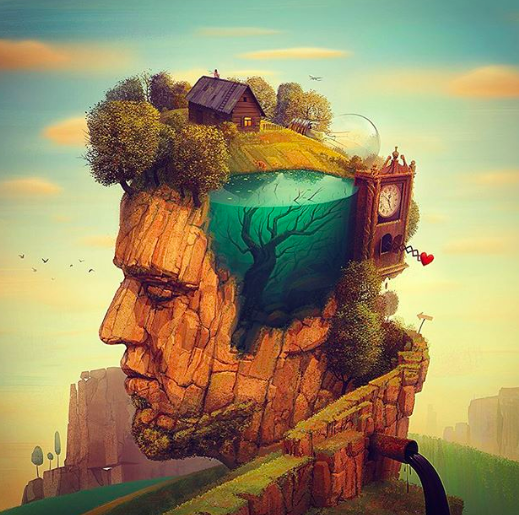
This is particularly evident in the corporality of Carroll’s world. Instead nonsense problematizes natural as well as nonsensical laws. Whilst Surrealism privileges an authenticity surrounding the violent displacement of the subject, nonsense commits to neither reality nor non-reality. Whilst in Surrealism this is a frankly violent displacement, Alice seems to take the nonsense in her stride, maintaining a specifically Victorian politeness – “fancy curtseying as you’re falling through the air!”

A subject that “is disposed of its privilege” of space must then imperatively experience a displaced reality. Alice’s perception of her fall has a vertiginous resonance “down, down, down” to a place where farcically “people walk with their heads downward.” Avant-garde tendency towards the perception of space and time correlates to the Surrealist agenda. Beer highlights the nonsensical behavior of this space “wells, however deep, do not usually affect the speed of falling.” Gravity is particularly inconsistent, as Alice falls, the jar of marmalade retains its ‘normal’ weight and she seems to fall faster than numerous cupboards. Having “plenty of time…to look about her and to wonder what was going to happen next” Alice surpasses geographical, temporal and rational boundaries. For the Surrealists Wonderland is a space of this unconscious aesthetic madness, navigated by Alice, a muse of feminine curiosity.Īlice’s fall, unlike Eve’s, is a leisurely and absurdly blithe experience. The perceived danger of feminine curiosity manifests itself in the reification of hysteria by the Surrealists as “women hysterics are endowed with particularly poetic powers because of that state of Otherness.” The Surrealist ideal of aesthetic madness, feminine irrationality and it’s access to the dream world has a natural alignment to Alice’s Wonderland of nonsense. For the Surrealists I would argue that this sense of danger manifests itself in an ambiguously conscious othering of woman. Woman’s invasion of this undetermined territory carries “connotations of transgression and danger” due to her “drive to investigate and uncover secrets.” Thus curiosity is often dismissed as madness or nonsense. Through the iconography of Pandora and the biblical figure of Eve, Mulvey argues that the myth of female curiosity projects itself “onto and into…forbidden space,” or for Alice, Wonderland. From its marginal position Alice’s curiosity stands to destabilize specifically patriarchal order. Louis Aragon treats Alice as a symbol of an endemically feminine curiosity “at an epoch when, in the definitively United Kingdom, all thought was considered so shocking that it might well have hesitated to form itself, what had become of human liberty? It rested in its entirety within the frail hands of Alice.” Thus the nonsense of Carroll’s text is given a specifically political agenda. Alice was a natural muse for the movement’s epistemophilia her characteristic curiosity, primordial drives and a particular dissatisfaction for arbitrary rules were beguiling to the Surrealist travail. Lewis Carroll’s canonical text of nonsense Alice in Wonderland was valorized by the Surrealists. Although parallels can be drawn between the two styles nonsense does not share the Surrealist confidence of subjective ‘transcendence,’ explicitly the reintegration of man and nature, subject and object and conscious and unconscious. The liminal consciousness of the subject, revered in Surrealism, is a much more troubled concept in nonsense literature. By inhabiting the ‘underground’ both Surrealism and nonsense occupy a vertiginous place in time and space. Surrealism seeks an epistemological identity through the marriage of conscious and unconscious realities.

If traditional nonsense plays with the unexpected disorder of the universe Surrealism makes a much more serious attempt to economize it.


 0 kommentar(er)
0 kommentar(er)
